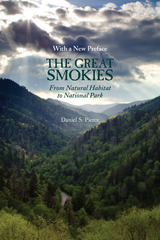
The new preface chronicles developments in the park since the book’s original publication in 2000. Over the past decade and a half, the park has experienced a dramatic and improbable improvement in air quality, a variety of successful animal reintroduction programs—including, most spectacularly, elk—numerous improvements to trails and roads, and the ending of long-standing dispute over the “Road to Nowhere,” which had its origins in the founding of the park eight decades ago. Pierce also points out new challenges that have emerged in the park—and there is none more dangerous than the invasive species known as the wooly adelgid, which threatens to annihilate the park’s 800 acres of old-growth hemlocks. The recent history of the Great Smoky Mountains National Park provides ample proof of Pierce’s conclusion: “just as people have the power to set aside places as wonderful as the Cataloochee Valley and the Great Smoky Mountains National Park, they also have the power to destroy it.”
Daniel S. Pierce is professor of history at the University of North Carolina, Asheville. He is the author of Real NASCAR: White Lightning, Red Clay, and Big Bill France, and Corn from a Jar: Moonshining in the Great Smoky Mountains.

The Smokies have, in fact, been a human habitat for 8,000 years, and that contact has molded the landscape as surely as natural forces have. In this book, Daniel S. Pierce examines land use in the Smokies over the centuries, describing the pageant of peoples who have inhabited these mountains and then focusing on the twentieth-century movement to create a national park.
Drawing on previously unexplored archival materials, Pierce presents the most balanced account available of the development of the park. He tells how park supporters set about raising money to buy the land—often from resistant timber companies—and describes the fierce infighting between wilderness advocates and tourism boosters over the shape the park would take. He also discloses the unfortunate human cost of the park’s creation: the displacement of the area’s inhabitants.
Pierce is especially insightful regarding the often-neglected history of the park since 1945. He looks at the problems caused by roadbuilding, tree blight, and air pollution that becomes trapped in the mountains’ natural haze. He also provides astute assessments of the Cades Cove restoration, the Fontana Lake road construction, and other recent developments involving the park.
Full of outstanding photographs and boasting a breadth of coverage unmatched in other books of its kind, The Great Smokies will help visitors better appreciate the wilderness experience they have sought. Pierce’s account makes us more aware of humanity's long interaction with the land while capturing the spirit of those idealistic environmentalists who realized their vision to protect it.
The Author: Daniel S. Pierce teaches in the department of history and the humanities program at the University of North Carolina, Asheville, and is a contributor to The Tennessee Encyclopedia of History and Culture.

“It is a seminal work and is ‘must reading’ for anyone seriously interested in the early interpretation of the Great Smoky Mountains.”—Arthur McDade, author of The Natural Arches of the Big South Fork
First published in a limited edition in 1975 by the author’s widow and now available in paperback for the first time, Out Under the Sky of the Great Smokies brings together the personal journals of a great environmentalist and nature writer.
The book combines descriptions of Broome’s innumerable hikes in the Great Smoky Mountains with extended meditations on the meaning of the mountains to the region as a whole. It is at once a historical document, preserving a perspective on the Smokies before full-scale development of the national park, and a work whose message about the importance of the environment is even more timely today than when it first appeared.
In a foreword written especially for this edition, the noted environmental writer Michael Frome describes the book as “a timeless work,” adding, “Here we find Harvey, the wilderness apostle on his home turf. He reveals himself exactly as I knew and loved him: a gentle spirit, sensitive to the needs of nature and humankind, always with tolerance and good humor.”
The Author: Harvey Broome (1902–1968) was born in Knoxville, Tennessee, and discovered the Great Smoky Mountain at an early age. An attorney, he helped found the Wilderness Society and served as president of the Smoky Mountains Hiking Club. He was the author of two other posthumously published books, Faces of the Wilderness and Harvey Broome: Earth Man.

“Carson Brewer at his absolute best.” – Sam Venable
Carson Brewer on…
Mountain places
Snow was nice and crunchy underfoot. Not crunchy like peanuts or cornflakes. Rather, it was a silky whispery crunchy.
Mountain plants
You can bury your nose deep in the cool violet bed and smell the mix of life and death while pondering the unceasing cycle of each into the other.
Mountain People
Lem Ownby…has plowed oxen, mules, and horses on the forty-four acre farm on Jakes Creek. But he has never owned or driven an automobile.
The Author: Carson Brewer was a reporter and columnist for more than forty years. His columns on conservation issues and on the Great Smoky Mountains earned him the E.J. Meeman Conservation Award (twice) from the Scripps-Howard Foundation, the Golden Press Card award from the Society of Professional Journalists (which also named a scholarship in his honor in 1984), and the inaugural Lifetime Achievement Award from the Knoxville Writers Guild. He died on January 15, 2003.
READERS
Browse our collection.
PUBLISHERS
See BiblioVault's publisher services.
STUDENT SERVICES
Files for college accessibility offices.
UChicago Accessibility Resources
home | accessibility | search | about | contact us
BiblioVault ® 2001 - 2024
The University of Chicago Press









